
Water | Resources
Toxics in the Environment Deadlier Than Violence….
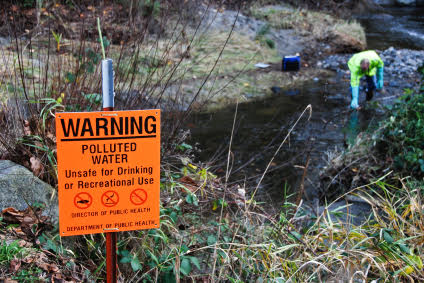
I haven’t subscribed to a newspaper for years, but now that I am living with Larry’s family, there’s a local newspaper on the table every morning. On Saturday morning I happened to glance down at the headline
DEADLIER THAN VIOLENCE
“They must be talking about toxics,” I thought. And I was right.
The story began:
Environmental pollution — from filthy air to contaminated water — is killing more people every year than all war and violence in the world. More than smoking, hunger or natural disasters. More than AIDS, tuberculosis and malaria combined.
And it went on to say:
One out of every six premature deaths in the world in 2015 — about 9 million — could be attributed to disease from toxic exposure…Experts say the 9 million premature deaths the study found was just a partial estimate, and the number of people killed by pollution is undoubtedly higher and will be quantified once more research is done and new methods of assessing harmful impacts are developed.
The financial cost from pollution-related death, sickness and welfare is equally massive, costing some $4.6 trillion in annual losses — or about 6.2 percent of the global economy.
This report is the first attempt to pull together data on disease and death caused by all forms of pollution combined.
ASSOCIATED PRESS: Study: Pollution kills 9 million a year, costs $4.6 trillion
Tiny Living in a Healthy Town
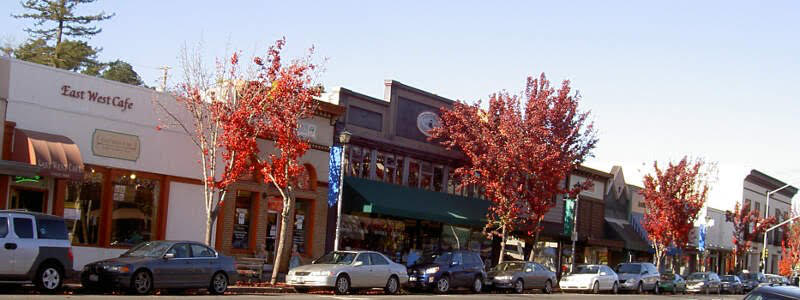
Sebastopol is the only town I’ve seen that has an independent bookstore, art supply store, and a music store right on main street, plus TWO organic food stores right near by.
Last week I wrote about how much I am loving living in Sebastopol California. This week I want to tell you more about how it’s healthy and the logistics of living here.
History of Sebastopol
Sebastopol was founded in the 1850s as a trading center for farmers and a site for a United States Post Office. After the Gold Rush of 1849m, more and more settlers came to California and many found a home in the fertile valleys north of San Francisco.
In 1875 botanist Luther Burbank came to Santa Rosa. Every school child in California knows Luther Burbank, who cultivated new varieties of fruits and vegetables through the traditional methods of seed-saving and grafting. No GMOs. With these simple methods he cultivated many new varieties in common use today, including the Russet potato, the most widely grown potato in the United States. Burbank’s experimental farm in Sebastopol is a wonderful place to visit, as is his home in Santa Rosa.
In the latest 1800s, a local farmer worked with Burbank to develop the Gravenstein apple for commercial use and Sebastopol became an apple boom town. Apples are so ingrained in the life of Sebastopol that even today, when many of the apple orchards have been replaced by vineyards, there is a free community apple press that can process 100 pounds of apples into cider in 20 minutes.
So from the very beginning, Sebastopol has been about food, farming, and health.
Coming Home to Sebastopol
I first came to Sebastopol about 30 years ago to visit the showroom of Shepherd’s Dream. While they are now located in Montague, California, Shepherd’s Dream started here in Sebastopol, and it was here that I worked with them to write the first standard for pure wool. The wool for the wool bed I sleep on came from local sheep near Sebastopol.
Around the same time, Larry’s parents purchased a lot in Sebastopol and built a house on it for their retirement. So I spent a lot of time in Sebastopol before I moved to Florida in 2002.
Today as I come home to Sebastopol after 15 years I see that much has changed and much is still the same. Many of the shops on historic Main Street are just the same, but there is now a vibrant farmer’s market, a wonderful new district called The Barlow that has transformed the site and buildings of an old applesauce factory into a vibrant artisan market district, and it’s just more crowded. Where before Sebastopol was a quiet town off the beaten path, it is now an integral part of the Napa-Sonoma wine industry.
I am here right now on grace. We didn’t choose to come to Sebastopol. We chose to come home and help our family. That our family is in Sebastopol is a gift. And I am thankful to be here every minute of every day. Life here agrees with me and I am loving exploring and experiencing this place.
The Cost of Living in This Healthy Town
Sebastopol is still a farm community, but it’s now much more expensive because of the value of the land for grapes and it’s proximity to San Francisco, which I think is now one of the most expensive places to live in America. Many of what used to be small family farms growing the foods of daily life, that same land is now growing gourmet wine. Still, there are many small farms growing specialty foods, but more and more land is going to grapes.
When I last lived in California in 2002. I had been paying a $2000/month mortgage for 12 years to live in a 700 square foot cabin. My whole life revolved around paying that mortgage and it was very difficult. This was part of the draw for me of moving to Florida. For the past 15 years I’ve been living in a 1600 square foot house with a $800/month mortgage. But even though I had a bigger house, I didn’t have quality of life.
Sebastopol clearly has the quality of life I want, but I wouldn’t be able to live here if I didn’t have family to stay with. I looked at the rentals just before writing this post and to rent a 700 square foot house is $3000. Hotel rooms on the weekend are $400/night. If you can find them. I mentioned to a farmer at the farmer’s market last week that I was looking for housing and she said, “Good luck. Any housing is hard o find.” And she was right. I think most people who live here now bought houses years ago.
Which brings me to tiny living.
Our Move Toward Tiny Living
Last week I wrote that Larry and I “have undertaken an enormous task of re-organizing our lives around ideas, abilities, relationships, experiences, adventures, and other such soul-satisfying interests rather than the pursuit of material goods.” With this goal in mind, we are simplifying our lives and reducing our possessions. And that’s why we are here. To reduce the pile of things Larry has collected over the years that are being stored at his parents.
But what has happened is pretty funny. My father used to say, “Be careful what you wish for because you just might get it.” Well, we are intending to live more small and simple. We’ve actually been watching all the tiny house shows on TV for months.
And what has happened is…we came here thinking we would have two rooms in Larry’s family house but for the moment we have only one. So we really have to live tiny! I don’t get a separate room for my office. We have one 12×16 room, That’s just under 200 square feet. The size of a smaller-size tiny house.
We can do this. When we first met we lived and worked in one room together.
Two things come to mind….
On tiny house tv shows people in tiny houses are always talking about quality of life. That they have exchanged their big houses and piles of belonging for more time and resources available for family, travel, education, and other pursuits of happiness. And we are experiencing that now. I was remembering this morning many years ago when I sold my grand piano because I was tired of moving it and buying or renting places big enough to hold it. If I were a concert pianist that would be one thing. But I hardly played it, so I sold it and fulfilled my lifetime dream of traveling through the British Isles. Today I am feeling the same about needing to carry so much stuff around with me if I want to go from place to place.
I’m also remembering something an architect friend said to me a number of years ago. We were talking about the ideal size for a home. And she said something about physical space versus living space. And how you don’t need to have all your living space in your home. Essentially we need a place to sleep, store clothing and other personal items, a place to bathe, a place to cook and eat, and for me, I need a place to do my work. But all of these do not need to be contained in a home. She considered her entire city as her “living space” and I’ve never forgotten that.
As we are gradually emptying our room to make space for our present needs, an interesting thing has happened. Larry started looking for a used trailer that we could transform into a tiny house space for my office. And as we started thinking about it, we saw we could build our own tiny house while we are living here and then have a tiny house when the time comes to leave. And that day will come. The house will be sold and we will need to live somewhere else. With a tiny house we could live anywhere.
And two weeks ago when the fires broke out and we had to escape the smoke, we could have just taken our tiny house anywhere if we already had one.
Living tiny in a way that’s mobile is looking more and more like our future. We’ll see what happens next.
Natamycin in Cheese

Question from Orsolya Csobi-Szabo
Hi Debra,
Do you consider Natamycin as a safe natural mold inhibitor used / added to most of the cheese products?
Thank you so much.
Debra’s Answer
Well, first thing is that it’s on the Whole Foods Market Unacceptable Ingredients for Food list.
You have asked me if I consider Natamycin to be safe and natural mold inhibitor.
It’s natural the sense that it material it is made from comes from nature (it’s not petrochemical).
Whether it’s safe or not is debatable.
But what I object to is that it’s an industrial additive that is only there so your cheese product does not mold. What I object to is industrial cheese products that are so old they need mold inhibitors.
Many cheeses get their flavor from mold added during the production process, such as blue cheese, which I love. But when cheese is cut and shredded and starts to mold, that’s an indicator that Nature is trying to break it down and return it to the ecosystem.
Your question brought to mind an experience I had yesterday at the farmer’s market when I ate some fresh goat cheese that the owner of the goats had just made right there at the farmer’s market. Such a gift. So delicious. That’s the cheese we should be eating. Not industrial cheese products.
Glass tea kettle and thermos
Question from TA
Hi Debra,
I’m wondering if you or your readers have any recommendations for glass (or other non-toxic) tea kettles and a thermos. I was using a stainless steel electric kettle from Hamilton Beach, but it stopped working. It boiled water very quickly, so I figured that a minute or so in the stainless steel probably wasn’t a significant leaching risk. Since it has stopped working, though, I’m pondering a glass one.
I’d like an electric one but haven’t succeeded in finding one that doesn’t have plastic pieces that come in contact with the water or steam. So I’ve looked for a stovetop one; I found one on Amazon that is glass, has good reviews that aren’t fake (I found several others that have fake reviews according to fakespot.com), and has a stainless lid. However, for borosilicate, there are always reviewers who say they use it on the stovetop and it’s okay, and then reviewers who say “Oh, I’d never use it on the stovetop.” Hmm…what to do?
I’d also like a glass thermos of some type to store the warm water in. Ideally, I could boil some water and store it to use throughout the day. I’d love to know of any that might be available. So far I haven’t found what I’m looking for. I have seen some double-walled glass mugs/tumblers, with varying reviews; but that wouldn’t keep the water warm all day. It would also be nice to have the thermos for transporting warm food on occasion. I saw an older style Thermos (brand name) that was plastic outside and glass lined inside — but the reviews were not good, and I believe the glass is lined with something anyway, so not just glass in contact with the food. Any suggestions? Maybe I need to think outside the box somehow.
Debra’s Answer
 |
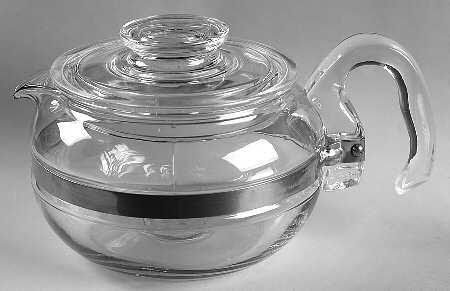 |
I use an Xtrema ceramic tea kettke to boil water.
I grew up with this exact Pyrex Flameware pot. It comes with a trivet to put on the burner below. I once left it too long and the water boiled away and it broke, but my mom bought another one. These are no longer made but used ones are available. No plastic at all. Search for “Pyrex Flameware 6 Cup Tea Kettle – Model 8126”
There are still thermoses with glass inside:
What is Viscose?
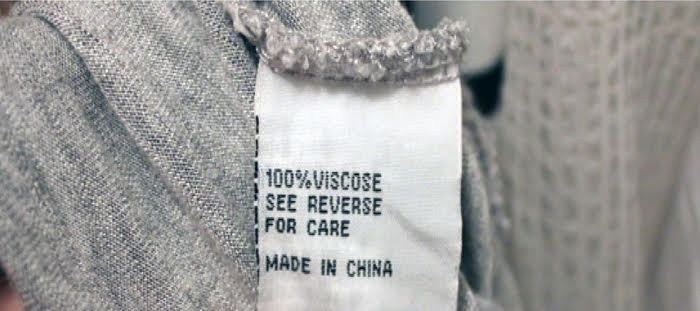
Question from Bonnie
Hi Debra,
What is viscose and is it somewhat safe to wear? I have found many t shirts made of this fabric and even bed sheets.
Debra’s Answer
Viscose is a brownish solution obtained by treating cellulose from plants with sodium hydroxide and carbon disulfide/ It is used to make rayon fiber and transparent cellulose film (cellophane).
The word is also used to refer to the rayon fabric or fiber made from viscose.
I think it is somewhat safe to wear. It’s a manmade industrial fiber. I occasionally buy a scarf made from viscose and once bought a dress-up dress made from it that I didn’t wear every day, but I wouldn’t sleep on viscose sheets every night.
FTC Takes Action Against Paint Companies for False Claims Regarding VOCs

Paint Companies Settle FTC Charges That They Misled Consumers; Claimed Products Are Emission- and VOC-free and Safe for Babies and other Sensitive Populations
Orders require companies to show paint emits no harmful chemicals at the time paint is applied when making unqualified zero-emission/zero-VOC Claims
Four paint companies have agreed to settle Federal Trade Commission charges that they deceptively promoted products as emission-free or containing zero volatile organic compounds (VOCs), including during and immediately after application. Some promotions also made explicit safety claims regarding babies, children, pregnant women, and other sensitive populations. However, the FTC alleged, the companies had no evidence to support these claims.
The four companies, Benjamin Moore & Co., Inc., ICP Construction Inc., YOLO Colorhouse, LLC, and Imperial Paints, LLC, have agreed to orders that would bar them from making unqualified emission-free and VOC-free claims unless, at all times during application and after, both content in and emissions from their paints are actually zero, or emissions are at “trace levels,” as defined in the orders.
The settlements also prohibit the companies from making other unsubstantiated health and environmental claims, and ensure that two of the companies disclose that seals appearing in their promotional materials are their own designations.
VOCs are carbon-containing compounds that easily evaporate at room temperatures. All paints emit chemicals during the painting process and while drying. Some of these chemicals can be harmful to the environment and people, especially to sensitive groups such as babies and those suffering from asthma or allergies.
In four separate complaints, the FTC charged each company with making unsubstantiated claims that their paints were free of emissions and/or that they contained no VOCs, without any qualification (e.g., after X number of hours). The FTC also charged the companies with facilitating deception by retailers who sold their paint. Additionally, in its complaints against Benjamin Moore and ICP Construction, the FTC alleged that the companies marketed their paint using environmental seals without disclosing to consumers that they had awarded the seal to their own products.
Each of the proposed consent orders settling the charges against Benjamin Moore & Co., Inc., Imperial Paints, LLC, YOLO Colorhouse, LLC, and ICP Construction Inc. contains four provisions designed to ensure the companies do not engage in similar conduct in the future.
First, they would prohibit the companies from making unqualified emission-free and VOC-free claims, unless both content and emissions are actually zero, or emissions are at trace levels, beginning at application and thereafter. The proposed orders’ definition of “trace level of emissions,” which generally tracks the Green Guides,’ “trace amount” test, requires, in part, that emission at that level does not cause material harm that consumers typically associate with emission from the covered product, including harm to the environment or human health.
Second, they would prohibit the companies from making claims about emission, VOC levels, odor, and other environmental or health benefits, unless they are true and not misleading, and unless the companies have competent and reliable scientific evidence to back them up.
Third, to correct existing unsubstantiated claims, the orders would require the companies to send letters to their distributors, instructing them to stop using existing marketing materials and providing stickers or placards to correct misleading claims appearing on product packaging or labeling.
Fourth, the orders would bar the companies from providing third parties with the means of making false, unsubstantiated, or misleading representations about material facts regarding paints described above.
The proposed orders against Benjamin Moore & Co., Inc. and ICP Construction Inc. contain two additional provisions, which would prohibit them from misrepresenting third-party certifications and failing to adequately disclose a material connection with an endorser.
The Commission vote to accept the consent agreements was 2-0. The FTC will publish a description of the consent agreement packages in the Federal Register shortly. The agreements will be subject to public comment for 30 days, beginning today and continuing through August 10, 2017, after which the Commission will decide whether to make the proposed consent orders final.
If the Commission finalizes the agreements’ proposed orders, it plans to propose harmonizing changes to two earlier consent orders issued in the similar PPG Architectural Finishes, Inc. (Docket No. C-4385) and The Sherwin-Williams Company (Docket No. C-4386) matters. Specifically, the Commission plans to issue orders to show cause why those matters should not be modified pursuant to Section 3.72(b) of the Commission Rules of Practice, 16 C.F.R. § 3.72(b).
Interested parties can submit comments electronically one or more of the proposed orders, including: Benjamin Moore & Co., Inc; Imperial Paints, LLC; ICP Construction Inc.; and YOLO Colorhouse, LLC.
NOTE: The Commission issues an administrative complaint when it has “reason to believe” that the law has been or is being violated, and it appears to the Commission that a proceeding is in the public interest. When the Commission issues a consent order on a final basis, it carries the force of law with respect to future actions. Each violation of such an order may result in a civil penalty of up to $40,654.
The Federal Trade Commission works to promote competition, and protect and educate consumers. You can learn more about consumer topics and file a consumer complaint online or by calling 1-877-FTC-HELP (382-4357). Like the FTC on Facebook(link is external), follow us on Twitter(link is external), read our blogs and subscribe to press releases for the latest FTC news and resources.
New Greenpeace Guide to Greener Electronics 2017
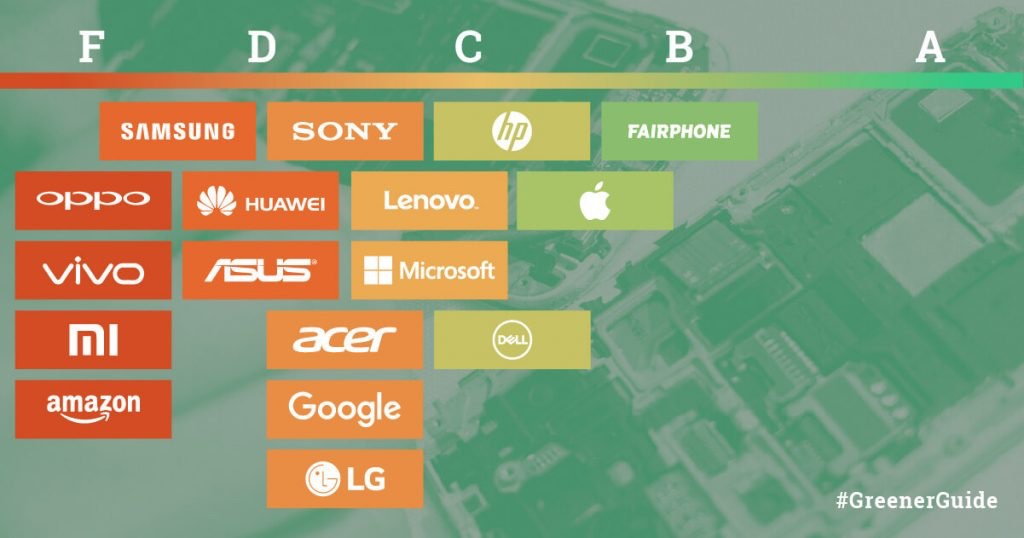
“With the relaunch of the Guide, we have focused on measuring elimination of hazardous chemicals from both the product itself and manufacturing.”
Samsung Trails Behind Apple in New
Greenpeace Guide to Greener Electronics
Average Grade Across 17 Companies Is D+,
Indicating Long Way to Go Toward Sustainable IT
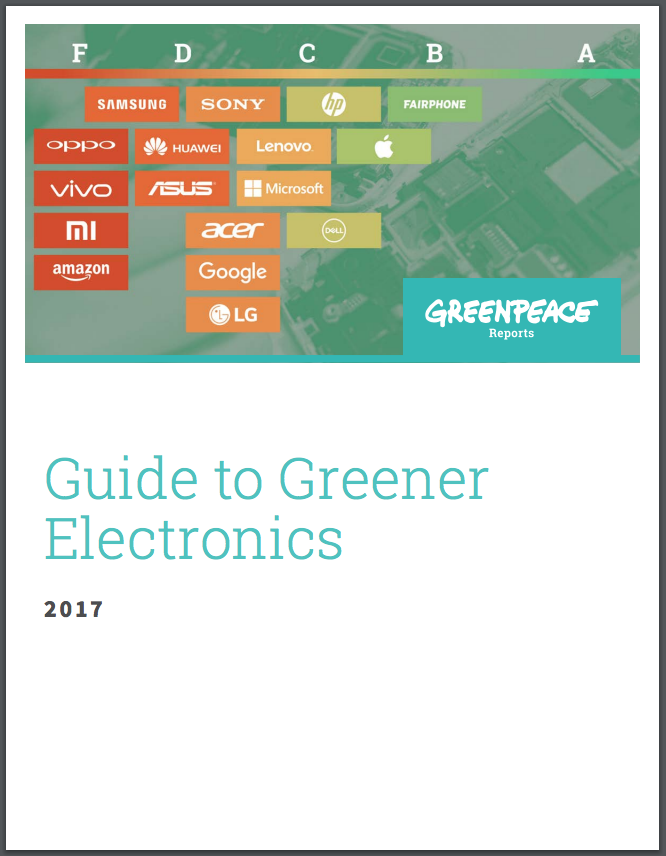 San Francisco, October 17, 2017 -The 2017 Guide to Greener Electronics (the Guide) was released today by Greenpeace USA, with rankings of seventeen of the world’s leading consumer electronics companies on sustainable manufacturing and design of IT products.
San Francisco, October 17, 2017 -The 2017 Guide to Greener Electronics (the Guide) was released today by Greenpeace USA, with rankings of seventeen of the world’s leading consumer electronics companies on sustainable manufacturing and design of IT products.
Companies were evaluated based on their transparency, commitment, performance and advocacy efforts in three critical areas: reduction of greenhouse gases through renewable energy; use of recycled materials; and elimination of hazardous chemicals.
“Tech companies claim to be at the forefront of innovation, but their supply chains are stuck in the Industrial Age. We know they can change. Rather than fueling climate change, IT companies need to show the way forward, just like Google and Apple have done with data centers run on renewables,” said Gary Cook, Senior IT Campaigner at Greenpeace USA.
The average grade across the 17 companies evaluated in the Guide was a D+, demonstrating that the sector as a whole has work to do to resolve supply chain impacts and improve product design. Fairphone, based in the Netherlands, scored best overall with a B, followed by Apple with a B-. Dell and HP follow Apple and Fairphone with a C+, while eleven companies, including Samsung, Huawei and Amazon, fall in the D and F range. The full list of rankings can be found here.
Despite its central position as both the largest manufacturer of smartphones and one of the largest suppliers of displays, Samsung’s manufacturing system relies heavily on fossil fuels. The company used more than 16,000 GWh of energy in 2016, with just 1% coming from renewables, for example.
Demand for consumer electronics continues to climb, with nearly 2 billion devices sold in 2016 alone. This drives demand for both finite mined materials and dirty energy. Meanwhile, e-waste is growing, due in part to the short lifespans of devices. The UN has estimated that e-waste globally will surpass 65 million tons in 2017–enough to bury San Francisco to 14 feet.
Key findings of the 2017 Guide to Greener Electronics include:
- Supply chain driving demand for dirty energy: Up to 80% of the carbon footprint of electronic devices occurs during manufacturing. While Google, Apple and other internet companies are making progress transitioning their data centers to renewable energy, nearly all of the companies in the Guide have yet to address the rapidly growing carbon footprint and dependence on dirty energy in their supply chains. Apple is the only company thus far that has committed to 100% renewable power for its supply chain.
- Planned obsolescence as design feature: Apple, Microsoft, and Samsung are among the companies moving in the wrong direction on sustainable product design – many of their latest products are difficult to repair or upgrade. HP, Dell, and Fairphone are the notable exceptions to this trend, producing a growing number of products that are repairable and upgradable.
- Poor supply chain transparency: Despite representing the majority of the environmental footprint for most electronic manufacturers, most companies publish little information on their suppliers, keeping their environmental footprint of their supply chain hidden from view. Of the 17 companies evaluated in the Guide, less than one third publishes a basic list of suppliers, keeping their supply chain hidden from view.
- Lack of transparency and monitoring of workplace chemicals: To protect worker health and safety, all companies need to identify and eliminate hazardous chemicals used in the production of their products, and improve worker health and safety due diligence. Apple, Dell, Google, HP, and Microsoft are the only companies in the Guide that publish their list of substances that must be restricted in the manufacturing of their devices (MRSL), including known hazards benzene, n-hexane, and toluene.
“It is clear the impacts of the linear take-make-waste business model employed by device manufacturers extend beyond the concerns of e-waste. We need to see greater ambition, more transparency, and follow-through from companies to address the environmental impacts of their enormous supply chains. The current model cannot be maintained,” said Cook.
Greenpeace is challenging the IT sector to take responsibility for its rapidly increasing footprint on the planet by:
- Shifting their supply chains to be renewably powered;
- Reducing the cycle of constant consumption of more minerals and other resources by designing long lasting products that use more recycled materials, and;
- Detox their products and their supply chain by finding alternatives to hazardous chemicals.
My Visit to the Naturepedic GOTS Certified Organic Mattress Factory
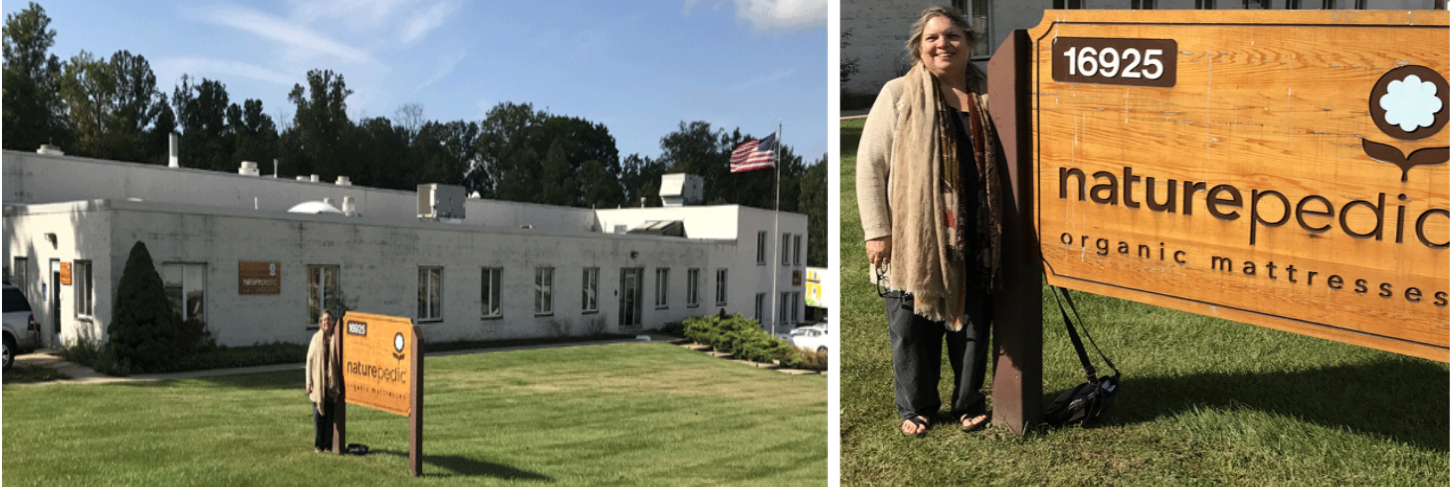
Read my post on the Naturepedic blog Understanding the Global Organic Textile Standard “Organic Mattress” Certification for more information about the GOTS standard and certification.
On 6 September 2017 I visited the Naturepedic mattress factory in Chagrin Falls, Ohio.
This charming village is in the countryside near Cleveland, built in the 1800s around a rushing waterfall in the center of town. The Naturepedic factory is just outside town in a quiet natural setting.
From the beginning, the Naturepedic factory was designed to be free from any toxic chemicals that might find their way into the mattress.
The mattresses are “handmade” in the sense that actual people are making the mattresses and bedding with their own hands. That said, there are also machines that make their work easier, such as sewing machines and heat sealers. There are also machines such as a vacuum machine that pulls all the air out of an innerspring mattress so it can be packed into a smaller box.
The concept of “aseembly line” is well used here, but instead of conveyer belts, products in progress are passed from person-to person, hand-to-hand. Some assembly steps are done by individuals, others by teams of people, such as two workers cutting a large sheet of fabric, their two pairs of scissors meeting in the middle.
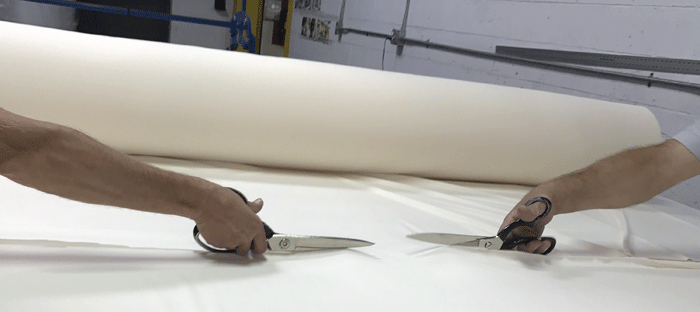
This is typical of the spirit of cooperation that runs throughout the factory.
Many of the workers are local Amish, who begin at 6:30 AM. They asked to start work at this hour because they are already up feeding the animals on their farms at 4 AM and they wanted to get right to work on mattress-making. It made me smile to learn the day before my visit the entire factory closed for the afternoon so everyone could attend the wedding of one of the Amish workers.
As I toured the factory, over and over again I observed excellent relationships between everyone there, at every level. Many of the workers have been with the company for a number of years, some since the beginning. And their experience shines through in the quality of Naturepedic products.
I was introduced to and spoke with many of the workers. I was delighted to hear from many of them how happy they were to work at Naturepedic because they agreed with the basic purpose of the company. One worker told me that he was from a factory town that was full of toxic factories that smelled bad and produced toxic products. He much preferred working at Naturepedic. There just is a lot of love here, and dedication to incorporating their ideals and vision in everything they do.
Being a GOTS Certified Organic Mattress Manufacturer and Facility, Naturepedic must follow strict guidelines:
- All cotton, wool, and other fiber materials must be certified organic.
- Latex must be certified organic (if mattress is also GOLS certified).
- All mattress accessories must be approved by GOTS and must demonstrate that they meet GOTS non-toxic requirements.
- Lot tracking of all materials and components.
Inspectors then come to the factory to ensure the requirements for certification are met.
Inspections include tracking use of materials plus an accounting of all the material entering and leaving the system to ensure the certified materials were used.
Materials are stored in a warehouse next to the workspace where the mattresses and bedding are constructed.
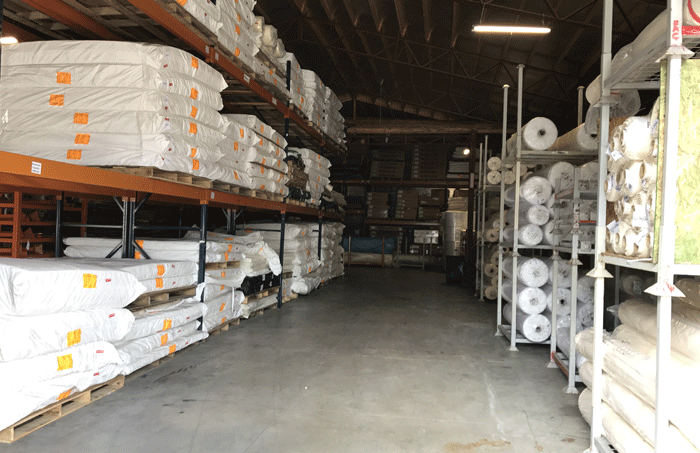
On the early autumn day when I visited, the doors were wide open and a clean breeze was blowing through. All materials are labeled and otherwise tracked for source, date, and anything else required by GOTS.
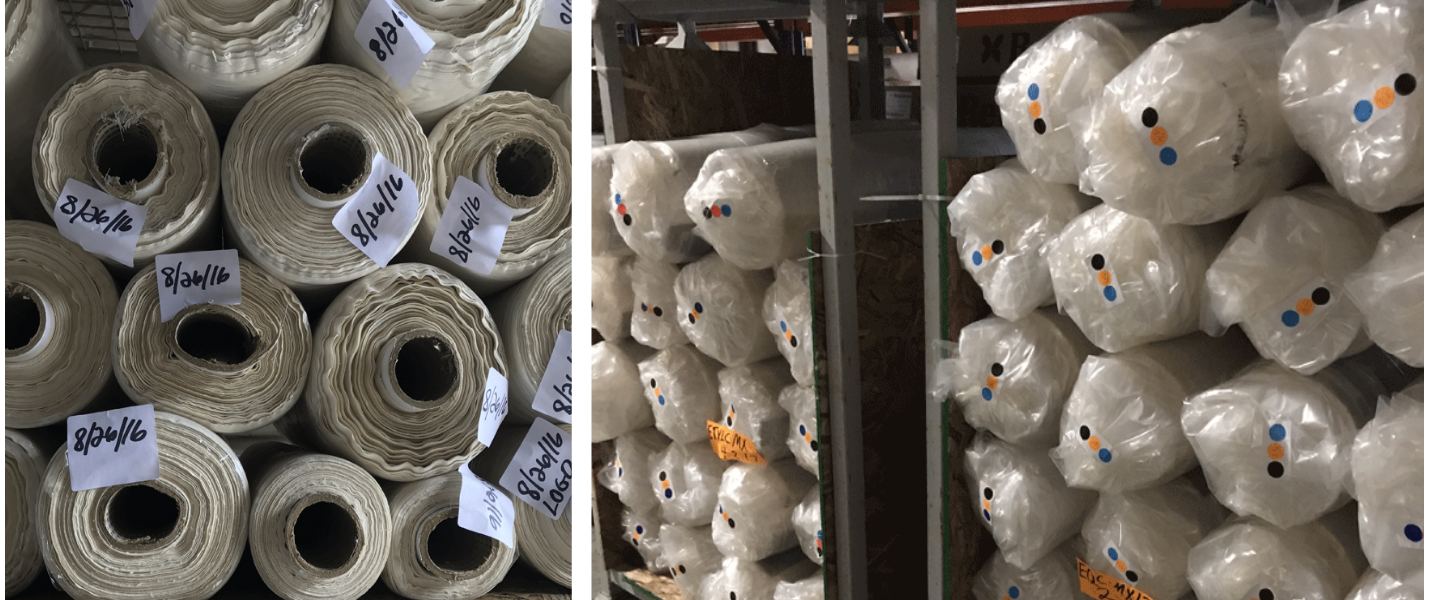
And at the end of the manufacturing process, a label is applied that lists all the materials used that shows the certifications.
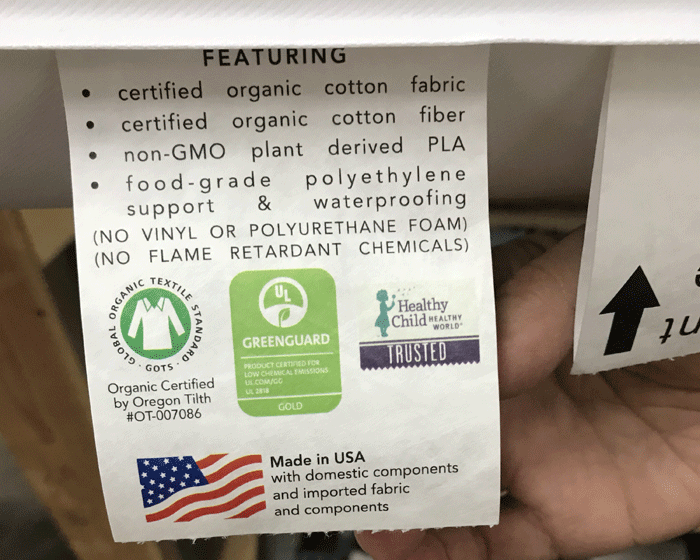
I spent the entire day at the factory and witnessed all the steps of making a mattress from start to finish—from the materials in the warehouse to the boxes being loaded on the shipping truck.
And at the end of the day I wished that every product in the world was manufactured like a Naturepedic mattress.
Public Health Officer Says “New Homes Burning Create Toxic Ash”
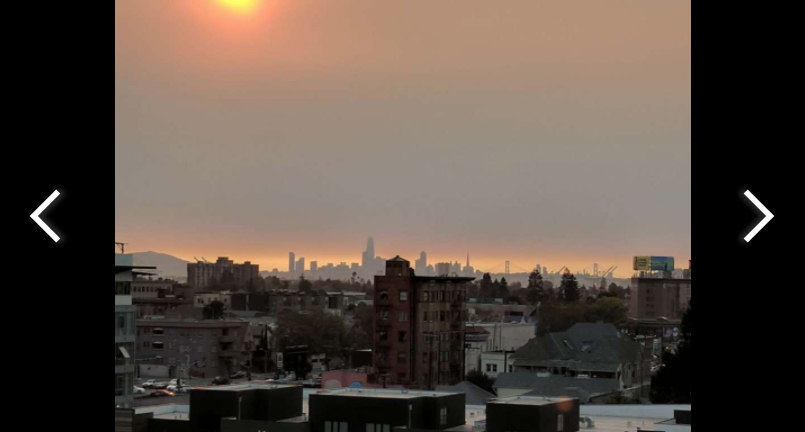
That’s the San Francisco skyline off in the distance. Click on the image to see an amazing collection of photos of our smoky skies here. When you click through the first image on the photo gallery is a woman with a scarf over her face. Just click on the right arrow to start viewing the smoky skies images.
After five days of fires in which more that 5000 homes and other buildings were destroyed near where I am living, Napa County Public Health Officer Dr. Karen Relucio declared a local health emergency throughout Napa County due to the hazardous waste and materials created by the fires.
We had been getting warnings about “unhealthy” levels of air quality daily since the fires started, but for the first time on Friday, those who have lost their homes were specifically told NOT to clean up fire debris because it was likely to be hazardous.
“The public should not attempt to clean up fire related debris,” Relucio said. “It is not safe. The ashes are toxic. They contain toxic materials.” She went on to note that the reason the ashes are toxics is “synthetic materials in new homes and household hazardous waste.”
I wish I could give you a link to her speech, but I can’t find it online. I saw it on tv news.
The ashes are toxic. The ashes are toxic. And the ashes from this fire are not limited to the debris on the ground. They are in the air all over the entire San Francisco Bay Area and beyond.
So when we’re breathing the air from smoky skies, it’s not just ash, it’s toxic ash the the public health department does not want us to even touch.
This is a serous public health issue.
If you live where there are smoky skies from burning buildings, it is imperative to stay in your home with an air filter and wear an appropriate mask when you are outdoors.
Choosing the Right Face Mask for Smokey Skies
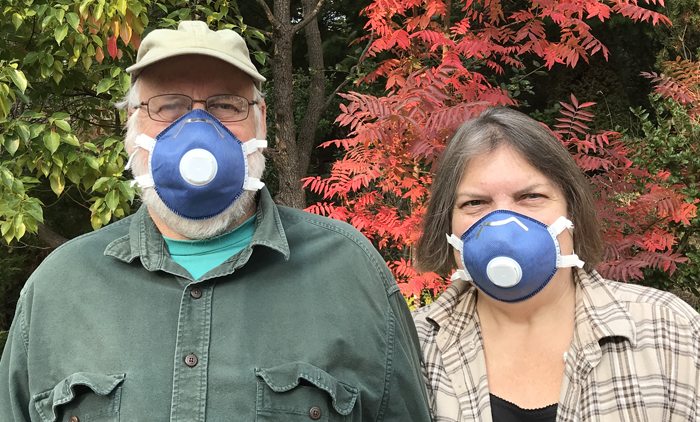
Debra and Larry wearing EnviroKlenz Face Masks
I’ve been living about 10 miles from one of the largest California fires ever for the past nine days now. It has produced a tremendous amount of smoke and ash all over the San Francisco Bay area, but especially right here where I am, near Santa Rosa.
There have been times when we literally could not breathe here without an air filter or face mask. At the end of the first day, Larry and I went to the beach to breathe, but by morning the smoke was there too.
It was very fortunate that I had an air filter in my storage unit. It has made it possible for us to breathe this past week, and I’m still sitting next to it as I write this today.
Smoke conditions in the outside air have been changing day-by-day depending on wind direction. I actually have never been in a situation where the air quality was so bad that I couldn’t breathe but one day last week I walked out the door and started coughing. We drove right to the hardware store to get a face mask. We had tried to buy facemasks a few days before but they were all sold out. That day they did have facemasks, but they were insufficient.
Facemasks are not a new subject for me. Many people with multiple chemical sensitivities (MCS) wear them all the time, as do some people who live in cities with air quality problems.
But since the need for a facemask is now imperative here, I decided to write about facemasks because there is a lot of misinformation in the news and in stores.
We all need to understand the health dangers present in smoky or polluted skies so we can then purchase the proper equipment to protect our lungs and our health
What You Need to Filter When There is Smoke in the Air
Smoke is made up of both particles and gasses. To choose a particle filter, you need to know about these pollutants.
Particles come in various sizes, which are measured in microns (also known as micrometers). Different types of particles have different sizes.
Particle pollution ratings are:
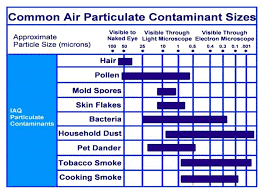
- PM10 : inhalable particles, with diameters that are generally 10 microns and smaller; and
- PM2.5 : fine inhalable particles, with diameters that are generally 2.5 microns and smaller.
Fine particles are the main cause of reduced visibility (haze) in the air. So if visibility is reduced in the air where you are, it’s full of fine particles.
Particles less than 10 microns in diameter pose the greatest health problems, because they can get deep into your lungs, and some may even get into your bloodstream. If the particles are toxic, then you run the risk of spreading toxic particles throughout your body when you breathe them. More on health and environmental effects of particulate matter.
Gasses are much simpler. In order to remove gasses from the air you are breathing you need a filter medium that will remove gasses, such as activated carbon or one of the new technologies that actually break down chemicals into natural elements.
Choosing the Right Face Mask
There are many face masks on the market, but they all fall into three basic types.
Medical Face Masks
 The most common face masks are medical face masks. My local CVS Pharmacy was giving these away for free, but they weren’t doing much good.
The most common face masks are medical face masks. My local CVS Pharmacy was giving these away for free, but they weren’t doing much good.
This is the kind of mask worn by dental and medical personnel to protect themselves from germs that might be carried by patients. It is also used in food service to keep food workers germs off food. Their purpose is to prevent the spread of disease.
They are made from non-woven fabric and filter paper.
If worn properly, a medical facemask will block large-particle droplets, splashes, sprays or splatter that may contain germs (viruses and bacteria), keeping them from reaching your mouth and nose. Facemasks can also help reduce exposure of your saliva and respiratory secretions to others. But medical face masks do not filter or block very small particles in the air that may be transmitted by coughs, sneezes or certain medical procedures. Facemasks also do not provide complete protection from germs and other contaminants because of the loose fit. If you want more protection from germs, use an N95 respirator (see below),
Medical face masks do not protect you from toxic particles or gasses found in smoke.
Face Masks for Particulates
Face masks for particulates will only filter PARTICLES, including dusts and biological micro-organisms. So they are good if you really need protection from germs or are in a situation where there is a lot of dust or smoke.
When you are choosing a particle mask, it needs to reduce exposure to particles down to the size particles you have in your air.
An N95 respirator is designed to block at least 95% of very small (0.3 micron) test particles when properly fitted. These are made from synthetic microfibers, adjustable metal nose clips and cushioning nose foam to provide a custom fit and a secure seal.
The N95 respirator are generally intended for occupational use, but the FDA has cleared certain N95 respirators (N95) for use by the general public. To work as expected, a N95 respirator requires a proper fit to your face. For information on proper fit, refer to the manufacturer’s instructions.
Our local news has been making a big point to only use “N95” particulate masks, however the Centers for Disease Control and Prevention (CDC) does not generally recommend facemasks and respirators for use in home or community settings. They recommend consulting with your health care provider for more information about when to use N95 Respirators at home or in the community.
There are a number of face masks of different types approved by the FDA (labels will say “NIOSH-approved”).
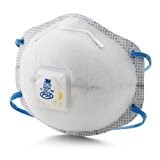 |
3M Particulate Masks See this page online for a wide selection of 3M N95 respirators. |
NOTE: N95 respirators are not designed for children or people with facial hair. Because a proper fit cannot be achieved on children and people with facial hair, the N95 respirator may not provide full protection.
NOTE: These masks may be made with all sorts of plastics and synthetic materials. Most are not suitable for people with MCS and some outgas air pollutants of their own.
There are quite a number of “N95” face masks on amazon in addition to the 3M models. Some descriptions don’t tell you what materials they are made from, others are decorative and don’t tell you the material used for filtration, some contain “an [unknown] antimicrobial agent that kills germs and lasts for the life of the mask.” Some are just cotton/polyester fabric with an antimicrobial…But none of these are FDA recommended.
If you need a dust mask, stick with a reputable brand that offers a mask that puts effectiveness first over style.
These masks will protect you from particles in smoke, but will NOT protect you from toxic gasses in smoke. They also need to be replaced frequently, depending on the concentration of particles in the air.
Face Masks for Smoke
We’ve been discussing the subject of face masks for smoke on this blog for quite some time, in the context of protection from exposure to cigarette smoke.
You can read the entire discussion at Q&A: Which Face Mask with Filter Cigarette Smoke?
The problem with smoke is that it contains toxic particles and toxic gasses and both need to be removed.
There are two face masks I am aware of that can protect users from smoke from any source and are designed to be safe for people with MCS.
 |
EnviroKlenz Breathing Mask
patented hospital-grade technology made from natural minerals neutralizes chemical gasses and particles |
|
 |
I Can Breathe Honeycomb Pollution Mask
Coconut shell activated carbon filter removes chemical gasses and particles |
Buy Here |
Respirators
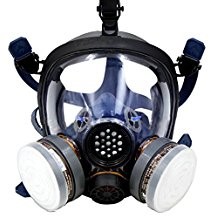 I just want to mention respirators. I’m not going to go into detail about them except to say that they exist. This is a post about face masks.
I just want to mention respirators. I’m not going to go into detail about them except to say that they exist. This is a post about face masks.
But I want you to know that heavy duty respirators do exist. They are especially designed for environments that have a high level of chemical gasses and are designed to hold replaceable cartridges.
Here is a list where you can see and compare some respirators.






